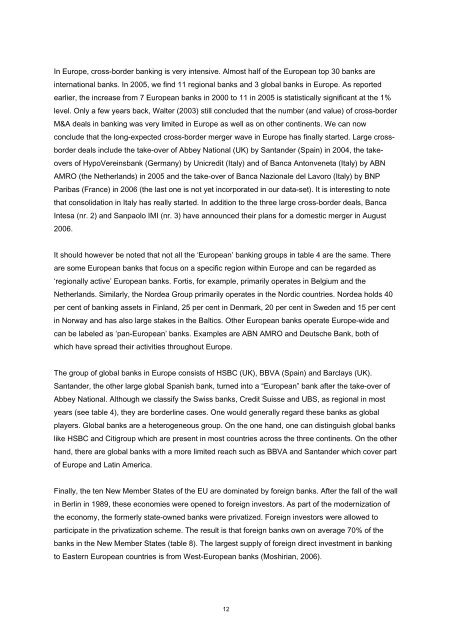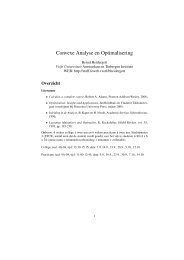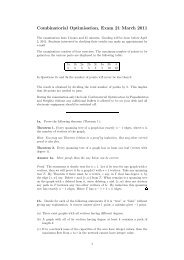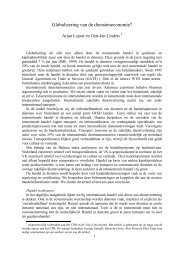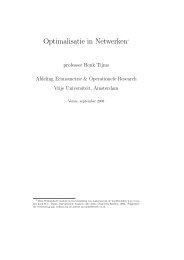Current State of Cross-Border Banking - Vrije Universiteit Amsterdam
Current State of Cross-Border Banking - Vrije Universiteit Amsterdam
Current State of Cross-Border Banking - Vrije Universiteit Amsterdam
Create successful ePaper yourself
Turn your PDF publications into a flip-book with our unique Google optimized e-Paper software.
In Europe, cross-border banking is very intensive. Almost half <strong>of</strong> the European top 30 banks are<br />
international banks. In 2005, we find 11 regional banks and 3 global banks in Europe. As reported<br />
earlier, the increase from 7 European banks in 2000 to 11 in 2005 is statistically significant at the 1%<br />
level. Only a few years back, Walter (2003) still concluded that the number (and value) <strong>of</strong> cross-border<br />
M&A deals in banking was very limited in Europe as well as on other continents. We can now<br />
conclude that the long-expected cross-border merger wave in Europe has finally started. Large crossborder<br />
deals include the take-over <strong>of</strong> Abbey National (UK) by Santander (Spain) in 2004, the takeovers<br />
<strong>of</strong> HypoVereinsbank (Germany) by Unicredit (Italy) and <strong>of</strong> Banca Antonveneta (Italy) by ABN<br />
AMRO (the Netherlands) in 2005 and the take-over <strong>of</strong> Banca Nazionale del Lavoro (Italy) by BNP<br />
Paribas (France) in 2006 (the last one is not yet incorporated in our data-set). It is interesting to note<br />
that consolidation in Italy has really started. In addition to the three large cross-border deals, Banca<br />
Intesa (nr. 2) and Sanpaolo IMI (nr. 3) have announced their plans for a domestic merger in August<br />
2006.<br />
It should however be noted that not all the ‘European’ banking groups in table 4 are the same. There<br />
are some European banks that focus on a specific region within Europe and can be regarded as<br />
‘regionally active’ European banks. Fortis, for example, primarily operates in Belgium and the<br />
Netherlands. Similarly, the Nordea Group primarily operates in the Nordic countries. Nordea holds 40<br />
per cent <strong>of</strong> banking assets in Finland, 25 per cent in Denmark, 20 per cent in Sweden and 15 per cent<br />
in Norway and has also large stakes in the Baltics. Other European banks operate Europe-wide and<br />
can be labeled as ’pan-European’ banks. Examples are ABN AMRO and Deutsche Bank, both <strong>of</strong><br />
which have spread their activities throughout Europe.<br />
The group <strong>of</strong> global banks in Europe consists <strong>of</strong> HSBC (UK), BBVA (Spain) and Barclays (UK).<br />
Santander, the other large global Spanish bank, turned into a “European” bank after the take-over <strong>of</strong><br />
Abbey National. Although we classify the Swiss banks, Credit Suisse and UBS, as regional in most<br />
years (see table 4), they are borderline cases. One would generally regard these banks as global<br />
players. Global banks are a heterogeneous group. On the one hand, one can distinguish global banks<br />
like HSBC and Citigroup which are present in most countries across the three continents. On the other<br />
hand, there are global banks with a more limited reach such as BBVA and Santander which cover part<br />
<strong>of</strong> Europe and Latin America.<br />
Finally, the ten New Member <strong>State</strong>s <strong>of</strong> the EU are dominated by foreign banks. After the fall <strong>of</strong> the wall<br />
in Berlin in 1989, these economies were opened to foreign investors. As part <strong>of</strong> the modernization <strong>of</strong><br />
the economy, the formerly state-owned banks were privatized. Foreign investors were allowed to<br />
participate in the privatization scheme. The result is that foreign banks own on average 70% <strong>of</strong> the<br />
banks in the New Member <strong>State</strong>s (table 8). The largest supply <strong>of</strong> foreign direct investment in banking<br />
to Eastern European countries is from West-European banks (Moshirian, 2006).<br />
12


